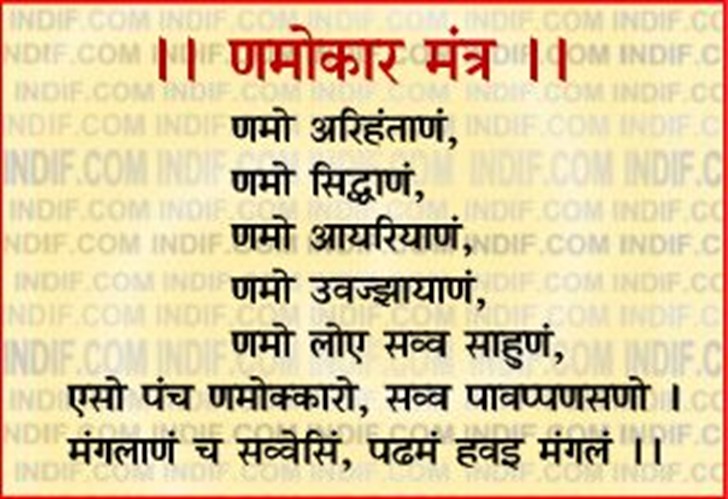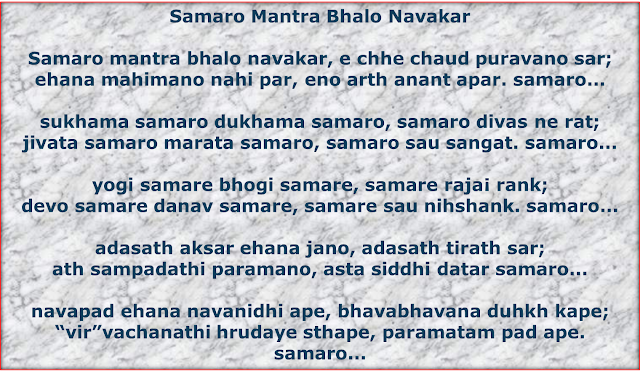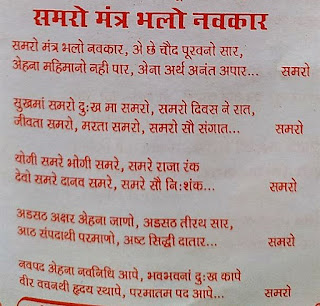||SAMRO MANTRA BHALO NAVKAR LYRICS- JAIN STAVAN SONG ||
To download song click HERE
||SHAMRO MANTRA BHALO NAVKARA - JAIN STAVAN: JAIN SONGS ||
|| समरो मंत्र भलो नवकर जैन स्तवन - जैन स्तवन ||
|| DOWNLOAD MP3 JAIN STAVAN SONG BHAJAN MP3 || ||SAMARO MANTRA BHALO NAVKAR LYRICS||
IF YOU ARE INTERESTED IN LIST OF ALL THE SONGS TO DOWNLOAD JUST CLICK THE BELOW HIGHLIGHTED BUTTON TO DOWNLOAD FROM GOOGLE DRIVE
to download it.
II Navkar Mantra (नवकार मंत्र) II
Navkar Mantra is the universal prayer of Jainism. The Navkar Mantra is the most important mantra in Jainism and can be recited at any time. This mantra is also called Namaskar (नमस्कार) or Namokar (णमोकार) Mantra. While reciting this mantra, the devotee bows with respect to humans who have cleared their gathi karmas (arihants), fully liberated souls (siddhas), spiritual leaders (acharyas), teachers (upajjhayas) and monks. Object: Deepest salutations to the five most auspicious beings.
 |
| NAVKAR MANTRA |
Namo Arihantanam
I bow in reverence to Arihants
Namo Siddhanam
I bow in reverence to Siddhas
Namo Ayariyanam
I bow in reverence to Acharyas
Namo Uvajjhayanam
I bow in reverence to Upadhyayas
Namo Loye Savva Sahunam
I bow in reverence to all Sadhus
Eso Panch Namukkaro
This five-fold salutation
Savva Pavappanasano
Destroys all sins
Mangalanam Cha Savvesim
And amongst all auspicious things
Padhamam Havai Mangalam
Is the most auspicious one
Explanation: Navakara Mantra is also known as Namaskara Mantra and Namokara Mantra. Navakara Mantra is composed of nine sentences (padas). It is the most revered mantra in Jaina religion. In first and second sentences, we pay our respect to perfect souls. In the third, fourth and fifth sentences we pay respect to the monks. The remaining four sentences explain the importance of this prayer. Some Jain traditions do not include the last four sentences in Navakara Mantra. The first seven padas each has a separate meaning while last two padas together have one meaning, thus for nine padas there are eight meanings (sampada). There are 68 whole letters in the original Prakrit version of the Navakara Mantra. These are the five supreme beings (parmeshthis), who are revered in this Mantra.
Arihanta: Siddha is the highest stage of bliss even above the state of Arihanta but in the Navakara Mantra, obeisance is offered first to Arihanta because they are perfect worldly souls, builders of the ford of righteousness, establishers of the four fold order of the Jaina community and they devote their lives in preaching and guiding other living beings to the path of liberation. Lord Arihanta has 12 attributes; which are made up of 8 auspicious symbols (pratihärya) and 4 extra ordinary powers (atishaya).
Twelve attributes of Arihanta are as follows:
1. Jnänätishaya: Omniscience, the perfect knowledge of past,present and future of the entire Universe at the same time.
2. Apäyäpagamätishaya: Lord Arihanta is free from all the faults and where ever he travels there is absence of all natural calamities and diseases within the area of 125 Yojanas (1 Yojana equals 4 miles) surrounding him.
3. Pujätishaya: All celestial beings and humans either worship or have desire to worship Lord Arihanta.
4. Vachanätishaya: The speech of Lord Arihanta is "The Reality" itself and well understood by celestial beings, humans and animals in their own mode of expression (native tongue) and has 35 special qualities.
5. Ashoka Vruksha: Where a divine assembly hall is built, a tree called Ashoka Vruksha, twelve times larger than the body of Lord Arihanta, is created by celestial beings. Lord Arihanta delivers his universal sermon sitting under this tree. Over Ashoka Vruksha, there is another tree called Chaitya Vruksha. It is under this Chaitya Vruksha lord Arihanta acquires perfect knowledge (Kevaljnäna).
6. Sura-pushpa vrushti: Shower of fragrant flowers by celestial beings.
7. Divya dhvani: The discourse of Lord Arihanta is accompanied by divine music in the background played by celestial beings.
8. Chämara: whisk
9. Sinhänsana: A divine golden throne studded with precious diamonds
10. Bhämandala: Halo behind the head of Tirthankara
11.Devadudumbhi: The celestial beings play the musical instruments during the samovsharana.
12. Chhatra: Divine three-tiered parasol above Tirthankara's head.
Of the above 12, 1 to 4 is extraordinary powers (atishaya) and 5 to 12 are symbols (prätihärya).
Siddha: Siddhas are liberated souls and are absolutely free from
the cycles of birth and death forever. The liberated souls live in an
abode called Siddha-shilä located at the top of the universe. Lord
Siddha has 8 attributes.
8 attributes of Siddhas are as follows:
1. Ananta-jnäna: Infinite knowledge due to destruction of knowledge obscuring (jnänävarniya) karma
2. Ananta Darshana: Infinite perception due to destruction of perception obscuring (darshanävarniya) karma.
3. Avyäbädha-sukha: Eternal bliss due to destruction of feeling producing (vedniya) karma.
4. Ananta-chäritra: Perfect conduct due to destruction of deluding (mohaniya) karma.
5. Akshaya-sthiti: Imperishable state due to destruction of age determining (äyu) karma.
6. Arupitva: Formlessness due to destruction of name determining (näma) karma.
7. Aguru-Laghutva: Not to heavy, not to light, a balanced immaterial form due to destruction of class determining (gore) karma.
8. Ananta-virya: Infinite energy due to destruction of energy restrictor (virya antaräya) karma.
Ächärya: Head of monastic congregation. Ächärya has 36 attributes. For a detailed discussion of Ächärya see the sutra number 2 page 7.
Upädhyäya: Ascetic preceptor. Upädhyäya has 25 attributes.
25 attributes of Upädhyäya are as follows:
Mastery of 11 Anga Ägamas, 12 Upanga Agamas, 1 Charanasittari (Text which deals in code of conduct) and 1 karanasittari. (Text,which deals in performing rituals and activities).
Sädhus and Sädhvis: Monks and nuns who have taken vows of
poverty (dikshä). Sädhus have 27 attributes.
27 attributes of Sädhus and Sädhvis are as follows:
Observe strictly five major vows (5)
Do not eat before sunrise and after sunset (6)
Give protection to six categories of living beings (chha käyä jivas),
i.e. one to five sensed living beings. (7-12)
Keep control on pleasures derived from any of five senses (13-17)
Avoid greed (18)
Forgive others (19)
Keep clear conscious (20)
Honest in dealing with personal clothes (21)
Practice five-fold vigilance (samiti) and three-fold self-control (gupti) (22)
Keep control over mental faculties (23)
Keep control over speech (24)
Keep control over physical actions (25)
Endure hardships (26)
Endure calamities (27)
In total there are 108 attributes of 5 supreme beings (Paramesthi)
IF YOU ARE INTERESTED IN LIST OF ALL THE SONGS TO DOWNLOAD JUST CLICK THE BELOW HIGHLIGHTED BUTTON TO DOWNLOAD FROM GOOGLE DRIVE
to download it
JAINAM JAYATI SHASHNAM






No comments:
Post a Comment